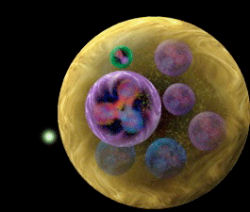Transparent Nuclei
A two-quark particle shot into a large nucleus is ordinarily absorbed, as its quarks interact with the nuclear quarks. But in some cases it can sail right through. Now a team reports in the 14 December Physical Review Letters that they have observed this so-called color transparency in the lower energy realm, where such quark-scale effects aren’t normally seen. The results–which are somewhat controversial–could help theorists who hope to bring the clean calculations of high energy, particle physics down into the messy world of lower energy nuclear physics.
Quarks have a “color” that attracts them to one another, somewhat like an electric charge. This force binds them together in threes (for protons and neutrons) or in twos (for pions and other mesons). The theory of quark interactions–quantum chromodynamics, or QCD–predicts that a quark-containing particle has a range of states with different physical sizes, from small to large. The particle’s measured size is an average over these different configurations, which exist simultaneously. QCD also says that a particle created at sufficiently high energy will start out in a small configuration with its quarks practically sitting on top of each other. In this short-lived state, the quarks will neutralize each other’s color, making the particle temporarily invisible to other quarks and thus able to escape the nucleus. This color transparency state is similar to a very small electric dipole, whose positive and negative charges nearly cancel each other out.
To observe the effect, researchers look for particles that form on one side of a nucleus and escape through the other side before expanding to normal size. Color transparency has been observed at energies above about 50 GeV, where QCD is relatively easy to calculate. But it should also exist at lower energies, where the theory of nuclear interactions is more challenging. One approach to those harder calculations is to divide the problem into two parts–for example, one involving smaller, “transparent” pion states, for which there is a good high-energy theory, and another involving larger pion states, says Gerald Miller of the University of Washington in Seattle. So documenting transparency at the lowest possible energies could help researchers solve some tough theory problems, he says.
Miller and his colleagues, using the electron beam at Jefferson Lab in Newport News, Virginia, report evidence of the onset of color transparency in medium-energy pions. The researchers studied collisions between 5 GeV electrons and various nuclear targets and carefully selected those events in which an electron struck a proton inside a nucleus, transforming it into a neutron and emitting a positively-charged pion. The fraction of pions that passed through the nucleus without being absorbed increased with energy. With a carbon target, for example, 60 percent of the pions having 2.5 GeV of energy escaped, whereas 75 percent of those with 5 GeV escaped. This energy-dependent absorption is not seen with pions created some distance away from a nucleus (with time to expand to normal size), so the team believes it has seen signs of color transparency. The results appear to match theoretical predictions by Miller and others.
But some researchers are skeptical that pions of small initial size can be completely sorted out from the huge background of normal-sized pions. Kawtar Hafidi of Argonne National Lab in Illinois and her colleagues have preliminary results with rho mesons–a cleaner test than pions, they believe–that do not show the same expected energy dependence, so she finds the new paper “hard to believe.” But team member Dipangkar Dutta of Mississippi State University says his group’s data also exhibit a dependence on nuclear size, which is further proof of color transparency.
–Michael Schirber
Michael Schirber is a Corresponding Editor for Physics Magazine based in Lyon, France.





